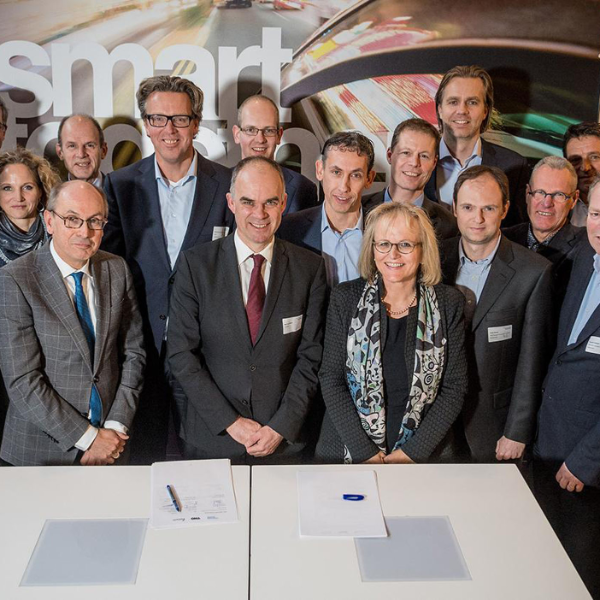SimSmartMobility simulation plan launched

SimSmartMobility simulation plan launched
Connecting Mobility, TNO and the Delft University of Technology will launch the first prototype of SimSmartMobility on 27 January 2017. Worldwide, SimSmartMobility is a unique simulation platform for replicating the mobility effects and potentially also liveability and safety effects of innovative mobility solutions. The prototype was developed over the past six months by the three project initiators.
The simulations are predicated on scientifically-based simulation models, fleshed out with real-life knowledge obtained from smart mobility projects and pilots. Collaboration between the parties is essential. During the #SmartTogether festival in Ede on Friday 27 January 2017, a letter of intent was signed by nineteen organisations:
- Antea Group B.V.
- Automotive NL B.V.
- Advin B.V.
- BEREIK!
- DAT.Mobility B.V.
- DTV Consultants;
- Dynniq Nederland B.V.
- Goudappel Coffeng B.V.
- MAP traffic management
- Movares
- Province of North Holland
- Province of North Brabant
- Royal Haskoning DHV
- Rijkswaterstaat
- Studio Bereikbaar
- Sweco Nederland B.V.
- TASS International Mobility Center B.V.
- TSS
- Witteveen+Bos
By taking this step, the parties want to make a contribution to accelerating the development of smart mobility services and products (nationally and internationally) and position the Netherlands as a frontrunner in this field. The signatories recognise that simulating smart mobility services facilitates faster and more targeted learning in practical trials. They also recognise they need to predicate validation of policy choices for smart mobility on validated estimates and forecasts. Ultimately, this will help to make validated and targeted investments in smart mobility, and thus make the mobility system in the Netherlands ready for the future. The development also presents an opportunity for Dutch businesses and knowledge institutions to put their knowledge in this field on the international map.
At present two different smart mobility services have been programmed in the prototype of SimSmartMobility to simulate the effects on mobility and liveability. The collaborating parties are going to develop the platform onwards in the coming period, for example by adding new smart mobility services, coupling new models and working on the presentational side. Similarly, demand side parties, like BEREIK! and the Province of North Brabant, have expressed their intention potentially to enter into cooperation, for example by putting forward concrete mobility issues. The initial simulations will be made using these issues. The simulated smart mobility services will subsequently be available to other demand-side parties as well. The platform will be refined with every submitted issue and every contributed model and service.
Marja van Strien (Connecting Mobility) said: “Simulations make the effects of smart mobility applications transparent beforehand. It helps policymakers, administrators and professionals to make validated policy choices and investment decisions”. Otto Schepers of Witteveen+Bos said: “Smart mobility is one of the major societal changes facing our global infrastructure and mobility. Developments are occurring so fast that we need to speed up innovation. We are pursuing this acceleration with a new Smart Mobility group. What’s more, we are going to set up in 2017 a Smart Mobility Innovation Hub to combine our global knowledge and contacts. We want to use the knowledge from the hub for the purpose of SimSmartMobility so as to give administrators and businesses a perspective for a faster response to what is still an uncertain future for smart mobility. We see clear opportunities for using virtual reality techniques for experiencing the deployment of smart mobility services, for providing training in using them and for evaluating them. We also see opportunities for integrating social and environmental effects in the simulation model in order to weigh up liveability and mobility integrally.